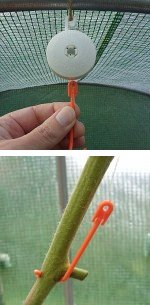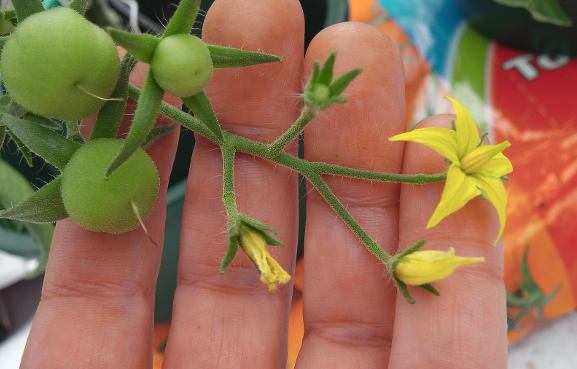Tomato Growing Newsletter – 6th June 2015 – for early summer looked at tomato plant supports, pruning and calcium.
By now, most of us will have our plants in their final position, getting them settled in and supported.
Hot Weather – Plant Stress – Root Systems
One of the few negative sides of a hot sunny spell at this time of the season is that plants haven’t yet established their roots systems.
They are easily stressed when losing moisture from their leaves faster than they are able to absorb it through their roots!
When this happens they close the holes on their leaves (stomata) to prevent moisture loss and plants becomes stressed.
The result of stress is often displayed as tight curly leaves at the top of a plant – where the new growth is made.
One way to help reduce the strength of direct sunlight is by using a sheet of garden fleece to reduce the light intensity. Hang it in front of your plants with a few clothes pegs.

Plants supports
Three popular methods:
- Canes
- String
- Yoyo’s
Truss Supports
- String
- Yoyo’s
- Plastic support clips
Pruning
Remove lower leaf branches – as soon as lower leaves begin to look old and patchy. Aeration is very important around the bottom of stems.
Also remove side shoots on tall (indeterminate – cordon) varieties unless you intend to allow a second or third stem to grow.
Truss Trimming
When flowers have set fruit, removing the stragglers from the end of a truss helps avoid wasting energy.

Medium and large varieties
It’s good to decide how many fruit you want from the first truss and remove the rest – after the flowers have set of course.
Allowing the first truss to grow indefinitely takes energy from the growth of upper trusses. This particularly applies to medium and large varieties.
Feeding and Upper Trusses
Once the first truss has set and fruit are beginning to ripen, a dose of nitrogen helps to promote the growth of upper trusses. This is a temporary boost for a week or two, then resume normal potash based tomato food feeding.
Calcium – The Solution!
When calcium is mixed in its liquid form with some nutrients, it precipitates, like rain out of the clouds. In other words, it drops out of the solution and will eventually create a white film around the sides of the container it is stored in.
Tomorite, a liquid feed, doesn’t contain calcium because of the reason stated above.
Chempak Standard Tomato Food does contain calcium because it comes in a dry form.
So how is this important for me?
If you are in a soft water area, that’s an area with low calcium in the tap water, it’s best to use Chempak Standard Tomato Food because it contains calcium.
If you are in a hard water area, Tomorite will be fine because the extra calcium is coming from your tap.
Of course good quality potting/multipurpose compost contains enough calcium anyway, but there are a number of reasons why calcium may be in short supply – even if there is plenty in the soil! We’ll discuss that another time.

If you suffer from Blossom End Rot
However, if you are in a soft water area, use Tomorite and regularly suffer from Blossom End Rot, you may like to move to a solid feed or add extra calcium – preferably as a foliar spray.
Ideas for comments below …
- Do you find that your medium and large varieties peter-out above the first truss?
- Does Blossom End Rot cause you a problem?
- Which tomato food works best for you?
That’s about it for this week and I hope you find the old newsletter format more useful.
Regards,
Nick
PS Comments and questions about tomato plant supports, pruning and calcium below please.

